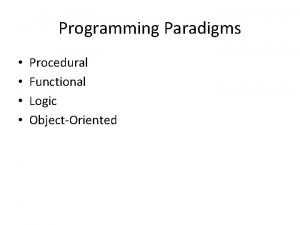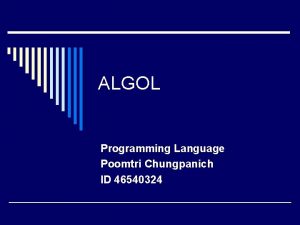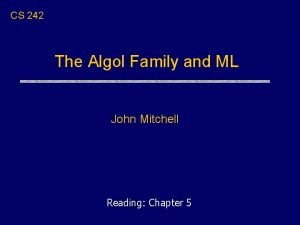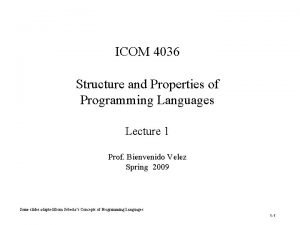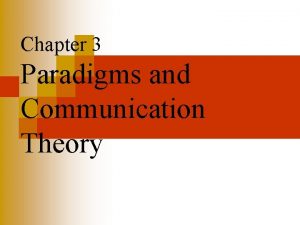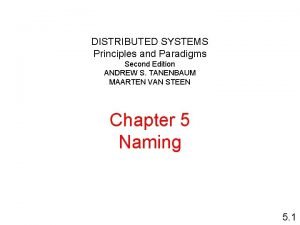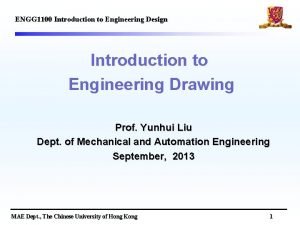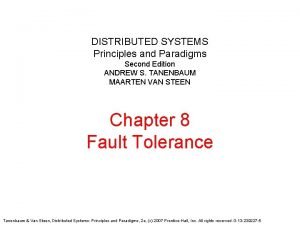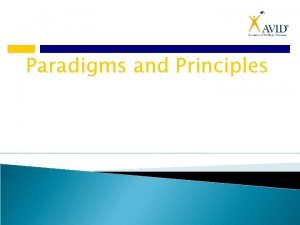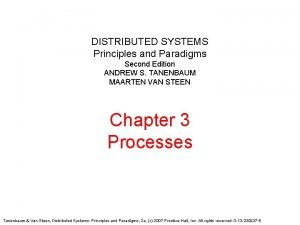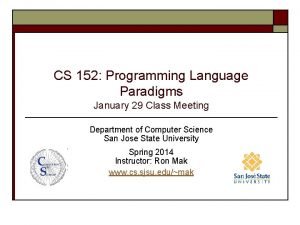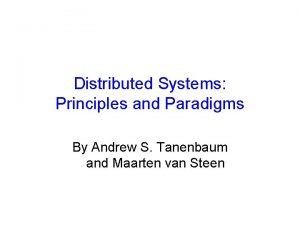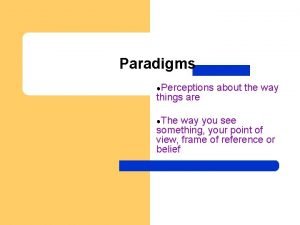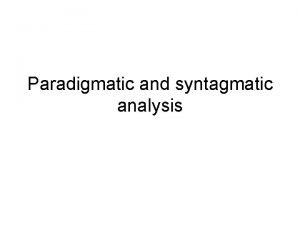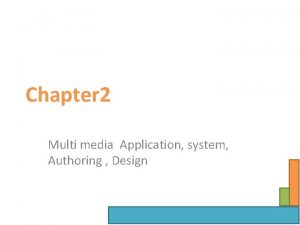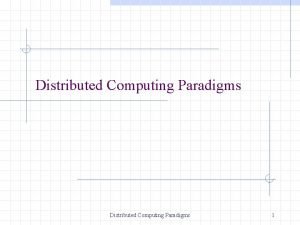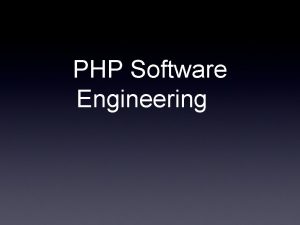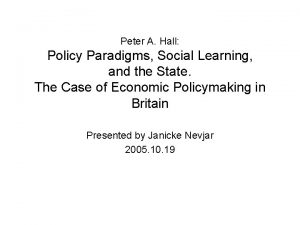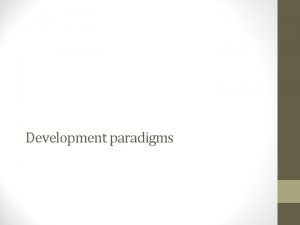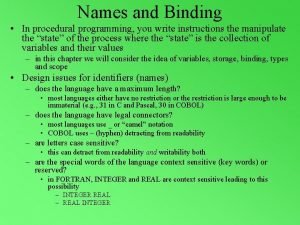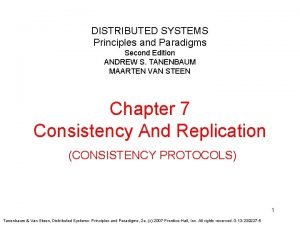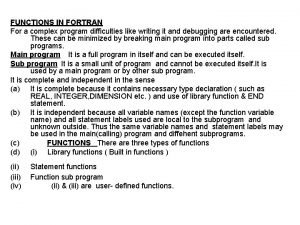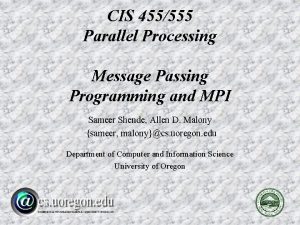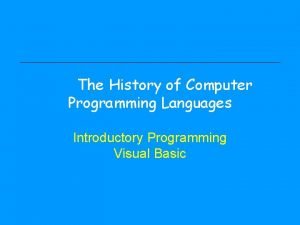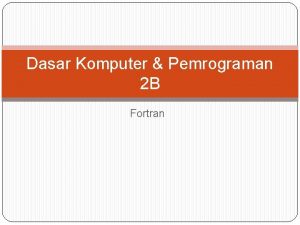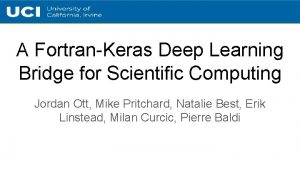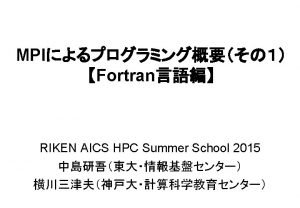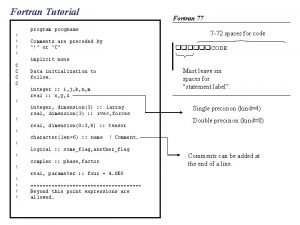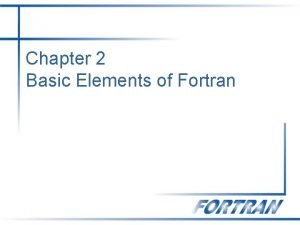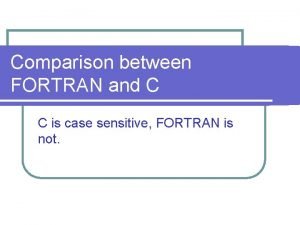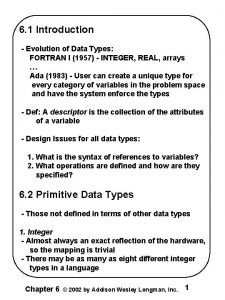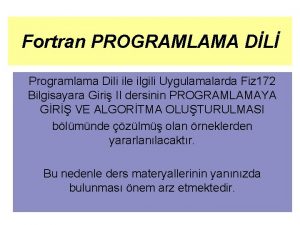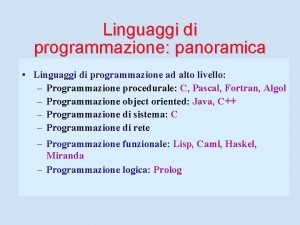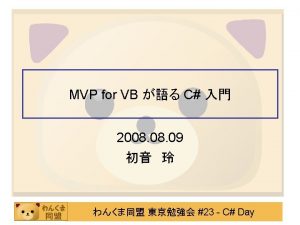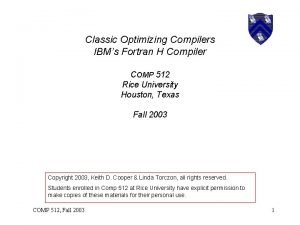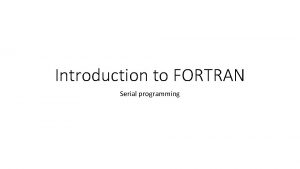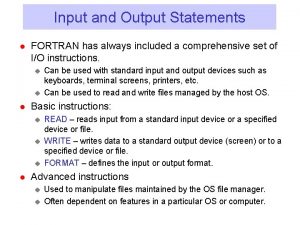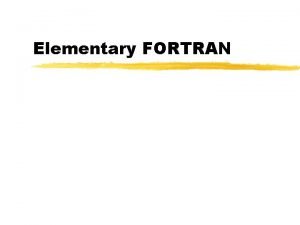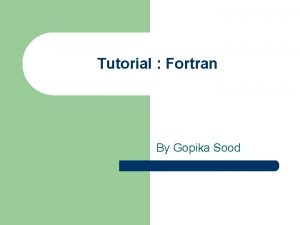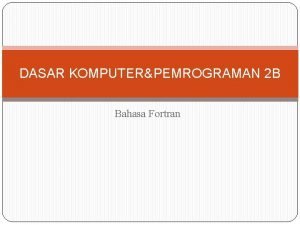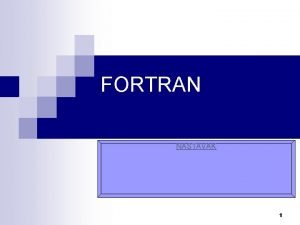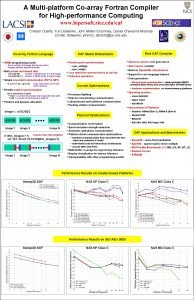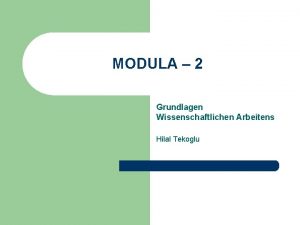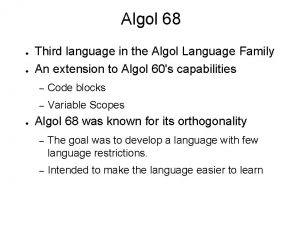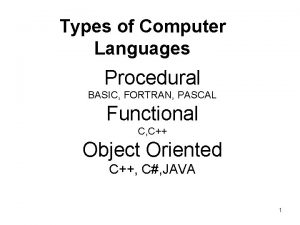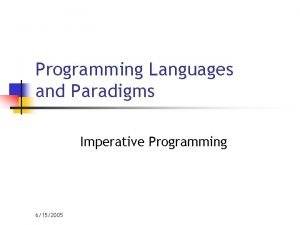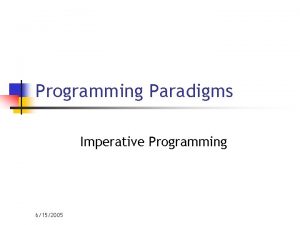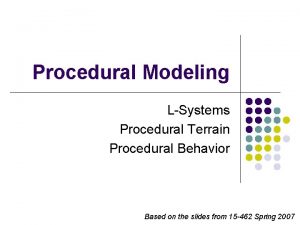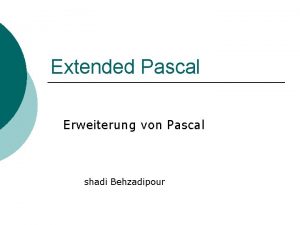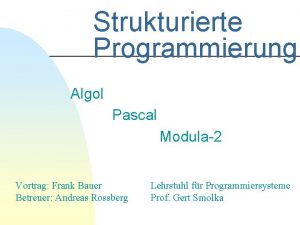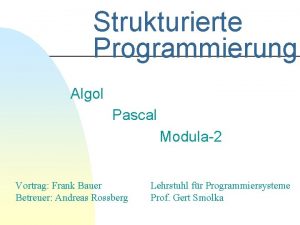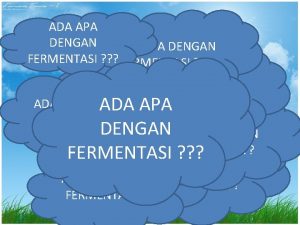Imperative Procedural Paradigms Fortran Algol Modula Ada Pascal


































































- Slides: 66

Imperative (Procedural) Paradigms Fortran, Algol, Modula , Ada, Pascal, C Programming Paradigms

Introduction Ä The imperative (procedural) programming paradigm is the oldest and the most traditional one. ü Ä An imperative program consists of explicit commands (instructions) and calls of procedures (subroutines) to be consequently executed. ü Ä It has grown from machine and assembler languages, whose main features reflect the John von Neuman’s principles of computer architecture. They carry out operations on data and modify the values of program variables (by means of assignment statements), as well as external environment. Within this paradigm variables are considered as containers for data similar to memory cells of computer memory.

Introduction Ä The imperative paradigm is the most popular programming paradigm because: ü Imperative programs tend to run much faster than other types of program. ü The imperative paradigm is much more in tune with the computer community's way of thinking. ü Programmers are prepared to sacrifice some of the advanced features of higher level languages in exchange for speed of execution. ü There is a tendency for programmers to get "bogged down" with control issues.

Imperative languages Ä Ä Programming languages can be grouped according to the characteristics that they display. Imperative languages have following characteristics: ü By default statements (commands) are executed in a step-wise, sequential, manner. û As a result order of execution is crucial. ü Destructive assignment. ü Control is the responsibility of the programmer û Programmers must explicitly concern themselves with issues such as memory allocation and declaration of variables. Ä Interpretation or compilation ? ü ü Most imperative languages are designed explicitly for compilation. Some very high-level imperative languages are interpreted (e. g. ICON).

Imperative programming Ä State-based, assignment-oriented approach: ü Ä A program is a sequence of state-changing actions. Any imperative program consists of ü Declarative statements which gives a name to a value. û A named value is called a variable. Thus, declarative statements create variables. û In procedural languages it is common for the same variable to keep changing value as the program runs. ü ü Ä Imperative statements which assign new values to variables. Program flow control statements which define order in which imperative statements are evaluated. Program units: ü ü Data: Variables and constants Computation: Statements and routines

Imperative programming Ä Example: var factorial = 1; /*Declarative statement*/ var argument = 5; var counter = 1; while (counter <= argument) /*Program flow statement*/ { factorial = factorial*counter; /*Imperative statement*/ counter++; }

Imperative programming Ä Oldest and most popular paradigm ü Fortran, Algol, C, Pascal … Ä Mirrors computer architecture ü In a von Neumann machine, memory holds instructions and data Ä Key operations: assignment ü Side effect: updating state (i. e. , memory) of the machine Ä Control-flow statements ü Unconditional (Go. To) and conditional branches, loops slide.

Imperative programming Ä Any imperative program manipulates an abstract machine with: Variables that name memory locations ü Arithmetic and logical operations ü Reference, evaluate, assign operations ü Explicit control flow statements ü Ä A programming language is said to be Turing complete if it contains Integer variables, values and operations ü Assignment statements ü Statement sequencing ü Conditionals (if) ü Branching statements (goto) ü

Imperative programming Ä An imperative programming language is one which is Turing complete and also (optionally) supports: ü Data types for real numbers, characters, strings, booleans and their operators ü For and while loops, case (switch) statements ü Arrays ü Records ü Input and output commands ü Pointers ü Procedures and functions

Structured programming Ä The concept of structured programming devised in late 1960 s (Dijkstra and others). Ä Emphasizes programming using sequences, conditions and repetition (no jumps and “goto” statements). Ä Constructs which have a predictable logic, i. e. they are entered at the top and exited at the bottom. Ä Structured programming enhances readability and hence maintainability.

Modular programming Ä The concept of modular programming was first taken seriously in the early 1970 s. Ä Modular programming is concerned with sub-division of programs into manageable “chunks”. Ä The concept also encompasses ideas about levels of abstraction. ü Modules are usually arranged in a hierarchy of abstraction. Ä Modularity also espouses the concept of information hiding.

Information hiding Ä It is concerned with the idea that the programmers attention shouldn’t be distracted by details not central to their current programming task. ü Programmers should not be required to be concerned with unnecessary details. Ä In the imperative paradigm this is achieved through the use of modules or packages. ü Modules (packages) should be designed so that information contained within those modules is “hidden” from other modules (packages).

Imperative programming languages Ä FORTRAN ü `The IBM Mathematical FORmula TRANslating system'. û Designed circa 1955 (by, amongst others, Backus). ü First successful attempt to improve on "assembly languages". û Still widely used for numerical applications. ü Has been revised to take account of ideas on structured programming etc. û However is decreasing in popularity.

Imperative programming languages Ä ALGOL’ 60 ü `ALGOrithmic Language 1960'. û Developed in 1950 s through a joint European-American committee. First block-structured language. ü First language whose syntax was defined using BNF. ü Direct ancestor of most modern imperative languages. ü Ä COBOL ü `COmmon Business Oriented Language' û Developed in 1950 s through a committee consisting mainly of US computer manufacturers. Designed to process large data files and is therefore the most extensively used language for data processing. ü Has been revised several times, but revisions have been unable to take into account programming concepts such as structured programming and modularity. ü

Imperative programming languages Ä BASIC ü ü Ä Beginner's All-purpose Symbolic Instruction Code. Teaching language made popular by the advent of the microcomputer in the mid 70 s. PL/1 Intended to be an all purpose programming language to support both scientific and data processing applications. ü Did not live up to its aspirations. ü Ä Algol'68 ü Ä Pascal ü Ä Successor to ALGOL'60. Proved less popular than its predecessor. A popular block structured teaching language devised by Niklaus Wirth. Simula'67 ü Simulation language, significance of which is that it introduced the "class" concept.

Imperative programming languages Ä Modula-2 ü Ä Ada ü Ä Pascal based language sponsored by the US Department of Defence. BCPL ü Ä Pascal extended with modules. Systems programming languages, significance of which is that it is a precursor to C. C Systems programming language used in the development of the UNIX system. ü Is at a lower level than most imperative languages. ü Standardised in 1988 to ANSI C. ü Ä C++

Features of imperative programming languages Ä They are usually "typed". ü Two main categories of imperative data type: û Basic data types. û Higher level data types. Ä Components comprise: ü ü ü Ä Ä Ä Data declarations. Expressions which yield values. Statements which carry out some operation, e. g. assignment statements, conditional statements, program constructs. An I/O mechanism. An error-handling mechanism. A method of grouping all of the above into a complete program (program composition).

Imperative programming Ä Examples: for i : = 1 to 10 do x : = x + 2*i; for (i = 1; i <= 10; i++) x = x+2*i; Pascal C DO 11 I=1, 10 X = X + 2*I 11 CONTINUE for i in 0. . 10 loop x : = x+2*i; end loop; ADA FORTRAN

Procedural programming Ä Procedure: ü the act, method or manner of proceeding in some process or course of action ü a particular course of action or way of doing something. Ä When imperative programming is combined with subprograms, it is called procedural programming.

Flowchart Ä Used to model imperative programs ü Based on the three control statements that are essential to have Turing machine capability. Ä Originated to describe process flow in general. ü Precursor of UML and other modern techniques. ü Basic blocks are:

Elements of imperative programs Ä Data type definitions Ä Variable declarations (usually typed) Ä Expressions and assignment statements Ä Control flow statements (usually structured) Ä Lexical scopes and blocks ü Goal: provide locality of reference Ä Declarations and definitions of procedures and functions (i. e. , parameterized blocks)

Data and Computation Ä Binding Ä Data ü Variables ü Data types Ä Computation ü Assignments and expressions ü Control structures ü Subprograms / routines

Binding Ä Program units/entities have attributes ü ü e. g. , a variable has a name, a statement has associated actions Examples: û û the meaning of a keyword such as if the operation associated with a symbol such as + the entity (variable, keyword, etc. ) represented by an identifier the memory location for the value of an identifier A binding in a program is an association of an attribute with a program component such as an identifier or a symbol. Ä The binding time for an attribute is the time at which the binding occurs. Ä ü ü In C the binding time for a variable type is when the program is compiled. In C the value of the variable is not bound until the program executes.

Binding Time Ä The most common binding times for attributes are (in chronological order): ü Language definition û Example: general meaning of symbol / in C because it is an operator. ü Language implementation û Example: size of an int in C. ü Program translation (compile time) û Example: specific meaning of symbol / in C: <int> / <int> or <float> / <float> ü Link edit û Example: specific computation performed by an external function ü Load û Example: memory address of a global variable ü Program execution (run time) û Examples: memory address of a local variable; value of a global variable

Variables Ä A named location in memory that can hold a value. ü Formally, a 5 -tuple: Name, Scope, Type, l-value, r-value Ä Name of variable ü Declaration ü Identifier rules and significant characters ü Name bound during compile time Ä Scope of variable ü Definition û range of instructions over which variable name is known û namespaces ü Blocks (as in Pascal or C) ü Static vs dynamic scope binding

Variables: Declaration Ä Typed variable declarations restrict the values that a variable may assume during program execution ü Built-in types (int, char …) or user-defined ü Initialization û What about C? Ä Variable size ü How much space needed to hold values of this variable? û C on a 32 -bit machine: sizeof(char) = 1 byte, sizeof(int) = 2/4 bytes, sizeof(float) = 4 bytes, sizeof(void *) = 4 bytes û What about this user-defined datatype: struct Data { int num; char *name; } union Data { int num; char *name; }

Data types Ä Purpose: classification and protection ü note that all data are ultimately represented as bit-strings Ä Consists of ü Set of values ü Operations Ä Built-in/Primitive vs User-defined types ü binding? Ä Implicit declarations ü e. g. , FORTRAN and first letter of a variable and first assignment in BASIC Ä Dynamic typing

Data types Ä Advantages: abstraction ü compile-time checking and resolution ü explicit specification ü Ä Types can be weak or strong. Strong type means that at any point in the program, when it is running, the type of a particular chunk of data (i. e. variable) is known. ü Weak type means that imperative operators may change a variable type. ü Example: ü var Person. Name; /*variable of a weak type”*/ Person. Name = 0; /*Person. Name is an “integer”*/ Person. Name = ‘Nick’; /*Person. Name is a “string”*/

Data types Ä Obviously, languages supporting weak variable types need sophisticated rules for type conversions. ü Example: var Person. Name; /*variable of a weak type”*/ Person. Name = 0; /*Person. Name is an “integer”*/ Person. Name = Person. Name + ‘Nick’ + 0; /*Person. Name is a string “ 0 Nick 0”*/ Ä To support weak typing, values are boxed together with information about their type - value and type are then passed around the program together.

Data types Ä Primitive data types Integer, Real, Decimal ü Character, String ü Boolean ü Ä User-defined data types (using type constructor) Pointer, Reference type ü Complex types ü û Enumeration, Subrange û Composite types û Aggregations – cartesian product (records or structures) – mapping (arrays, associative array) – unions

Variables: Location and values Ä When a variable is declared, it is bound to some memory location and becomes its identifier ü Ä l-value: ü Ä Memory location (address) û lifetime û Memory allocation r-value ü Ä Location could be in global, heap, or stack storage. Value stored at the memory location identified by l-value û initialization û constants Assignment: A (target) = B (expression) ü Destructive update: overwrites the memory location identified by A with a value of expression B.

Copy vs. Reference Semantics Ä Copy semantics ü Expression is evaluated to a value, which is copied to the target. ü Used by imperative languages. Ä Reference semantics ü Expression is evaluated to an object, whose pointer is copied to the target. ü Used by object-oriented languages.

Variables: Assignment Ä On the right hand side (RHS) of an assignment, use the variable’s r-value; on the left hand side (LHS), use its l-value ü Example: x = x+1 û Meaning: “get r-value of x, add 1, store the result into the l-value of x” Ä An expression that does not have an l-value cannot appear on the LHS of an assignment ü What expressions don’t have l-values? û Examples: 1=x+1, ++x++ û What about a[1] = x+1, where a is an array?

l-values and r-values Ä Any expression or assignment statement in an imperative language can be understood in terms of l-values and r-values of variables involved ü In C, also helps with complex pointer dereferencing and pointer arithmetic Ä Literal constants ü Have r-values, but not l-values Ä Variables ü Have both r-values and l-values ü Example: x=x*y û Means “multiply r-value of x by r-value of y and store it in l-value of x”

l-values and r-values int x = 5; // lvalue(x) is some (stack) address, rvalue(x) == 5 Ä Pointer variables int *p = &x; // lvalue(x) is some (stack) address, rvalue(x) ü Their r-values are l-values of another variable == 5 û Intuition: *p =the 2 *value x; of a pointer is an address Ä Overriding r-value and l-value computation in C ü &x always returns l-value of x ü *p always return r-value of p û If p is a pointer, this is an l-value of another variable int x = 5; int *p = &x; *p = 2 * x; lvalue(x) is some (stack) address, rvalue(x) == 5 rvalue(p) == lvalue(x) rvalue(p) <- rvalue(2) * rvalue(x) The value of x is 10 after this point

Block-structured languages Ä Examples ü ü Ä { … } -> C begin … end -> Algol, Pascal, Modula Two forms of blocks ü Inline blocks û Data structure stored on run-time stack û Contains space for local variables ü Ä Blocks associated with functions or procedures Nested blocks ü ü Local/global variables Storage management û Enter block: allocate space for variables û Exit block: some or all space may be deallocated

Simplified machine model

Simplified machine model Ä Registers, Code segment, Program counter ü Ignore registers (for our purposes) and details of instruction set Ä Data segment ü Stack contains data related to block entry/exit ü Heap contains data of varying lifetime ü Environment pointer points to current stack position û Block entry: add new activation record to stack û Block exit: remove most recent activation record

Scope & Lifetime of variables Ä Scope ü Region of program text where declaration is visible Ä Lifetime ü Period of time when location is allocated to program Ä Example: ü Inner declaration of x hides outer one (“hole in scope”) ü Lifetime of outer x includes time when inner block is executed û Lifetime ≠ scope

Structured control flow Control structures are program building blocks that determine the order in which statements in a program are executed Ä Control flow in imperative languages is most often designed to be sequential Ä ü ü Ä Instructions executed in order they are written Some also support concurrent execution Program is structured if control flow is evident from syntactic (static) structure of program text Big idea: programmers can reason about dynamic execution of a program by just analyzing program text ü Eliminate complexity by creating language constructs for common controlflow “patterns” ü û Iteration, selection, procedures/functions

Structured control flow Ä The structure theorem states that all programming problems can be solved by using 3 control structures ü Sequence ü Selection ü Repetition

Structured programming Ä A disciplined approach to imperative program design. Ä Uses procedural abstraction and top-down design to identify program components Ä Does not use goto statements ü Example: û FORTRAN control structure

Historical debate Ä Dijkstra, “GO TO Statement Considered Harmful” ü Letter to Editor, Comm. ACM, March 1968 ü Linked from the course website Ä Knuth, “Structured Programing with Go To Statements” ü You can use goto, but do so in structured way … Ä Continued discussion ü Welch, “GOTO (Considered Harmful)n, n is Odd” Ä General questions ü Do syntactic rules force good programming style? ü Can they help?

Modern style Ä Standard constructs that structure jumps if … then … else … end while … do … end for … { … } case … Ä Group code in logical blocks Ä Avoid explicit jumps (except function return) Ä Cannot jump into the middle of a block or function body

Expressions & Statements Ä Operators ü ü ü Ä Unary, binary, and others (functions? ) Value returned vs effect Precedence rules & Associativity rules Operands: variables, literals ü ü Order of evaluation: Operator & Operand Order of operand û Functional side effect ü Short-circuit evaluation û Side effect in expression Ä Statements ü ü ü The semicolon: C (terminator) vs Pascal (separator) Blocks: C { } vs Pascal (begin-end) Control structures: decision, iteration, routines

Selection Ä Allows programs to “select” a set of instructions to execute based on the presence (or absence) of a condition. ü This is a conditional execution: conditions and Boolean values. Ä Most programming languages have 2 selection statements ü Two-way selector( if in C, if in Pascal, IF in FORTRAN) û Single- and multi-statement body û Someone don’t have an “else” part ü Arithmetic IF-statement – FORTRAN IF (X) 10, 20, 30 ü Multi-way selector (switch in C, case in Pascal)

Selection Ä Examples: ü if with multi-statement body If <condition> Then <statements to execute when true> Else <statements to execute when false> End If ü if with single-statement body If <condition> Then <the statement to execute when true> Else <the statement to execute when false>

Selection problem Ä Assume that you have been asked to write a program to find the largest of a set of 3 numbers. The user will enter 3 integers between 0 and 100. The program will display appropriate messages and display the largest of the 3 numbers. Find. Largest (Version 1) Get Num 1, Num 2 and Num 3 If Num 1 > Num 2 Then Largest = Num 1 Else Largest = Num 2 End If If Num 3 > Largest Then Largest = Num 3 End If Display label and Largest End Find. Largest (Version 2) Get Num 1, Num 2 and Num 3 If Num 1 > Num 2 Then If Num 3 > Num 1 Then Largest = Num 3 Else Largest = Num 1 End If Else If Num 3 > Num 2 Then Largest = Num 3 Else Largest = Num 2 End If Display label and Largest End Find. Largest (Version 3) Get Num 1, Num 2 and Num 3 If Num 1 > Num 2 and Num 1 > Num 3 Then Largest = Num 1 Else If Num 1 > Num 2 and Num 3 > Num 1 Then Largest = Num 3 Else If Num 2 > Num 1 and Num 2 > Num 3 Then Largest = Num 2 Else If Num 2 > Num 1 and Num 3 > Num 2 Then Largest = Num 3 End If Display label and Largest End

Selection problem Ä Many kinds of “variations” of two-way selection. ü This one doesn’t have an “else” part ü This one has a cascade “else” part (more than one “else”) If <condition> Then <statements to execute when true> End If If <condition 1> Then <statements to execute if condition 1 is true> Else If <condition 2> Then <statements to execute if condition 2 is true> Else If <condition 3> Then <Statements to execute if condition 3 is true> … Else <Statements to execute if all conditions are false> End If

Selection problem Ä Many kinds of “variations” of two-way selection. ü This one is “nested” If <condition 1> Then <statements to execute if condition 1 is true> Else If <condition 2> Then <statements to execute if condition 2 is true and condition 1 is false> Else <statements to execute if condition 2 is false and condition 1 is false> End If ü Conditions can be more complex too û Most programming languages have logical operators that can be used to make compound conditions (NOT, AND, OR, XOR)

Multi-way selection Ä Many programming languages have another kind of selection statement – the multi-way selector (case statement) Ä Case statements ü Are very different in structure and function in different programming languages. ü Examples: case letter is when 'a'. . 'z'| 'A'. . 'Z' => put (“ 1"); when '0'. . '9' => put (“ 2"); put(“ 3”); when ‘&' => put (“ 4"); when others => put (“default"); end case; ADA case I of 7: write(2); 2: begin write(5); write(1) end; 99: write(7) end; Pascal switch ( i ) { case 3: i +=10; case 1: i += -5; break; default: i = 0; } C

Iteration Ä Definite ü Iteration steps are fixed – a control variable has fixed original_value, final_value and iteration_step_size. DO 20, I = 0, 100, 3 WRITE(*, *) I 20 CONTINUE for i: = 1 downto 100 do write(i); FORTRAN Ä Pascal Indefinite ü Termination depends on a dynamically computed value: pre-checked loop or post-checked loop. do { break in C k = scanf(“%d”, &a); } while (k != 1 || i <= 0); Ä “Breaking Out” of a loop: Ä Forced loop re-entry: continue in C C repeat read( a ); until (a > 0); Pascal

Routines Ä Program unit ü Named sequence of instructions with defined input/output interface. Ä Main problems ü Procedures and functions ü Local referencing environments ü Parameter-passing methods û By value û By reference û Others? (call by value-result, call by name) û Procedures as parameters

Routines Ä Program unit ü Named sequence of instructions with defined input/output interface. Ä Main problems ü Activation records û Formal parameters: indicated in routine definition û Actual parameters: indicated in invocation ü Overloaded subprograms û User-defined overloaded operator ü Generic subprograms ü Recursion ü Coroutines

Routines Ä Programmers have dreamed/attempted of building systems from a library of reusable software components bound together with a little new code. ü Imperative (procedural) programming paradigm is essentially based on concept of so-called “Functions” also known as “Modules”, “Procedures” or “Subroutines”. function factorial(parameter) Ä A function is a section of code that is parceled off from the main { program and hidden behind an interface: var i = 1; result =here 1; generating a ü The code within the function performs a particularvar activity, factorial value. while(i <= parameter) { is to provide a single point of ü The idea of parceling the code off into a subroutine result = result * i; entry. i++; û Anyone wanting a new factorial value has only to call the “factorial” function with the } appropriate parameters. return(result); }

Functions vs. Procedures Ä Difference: functions return a value, procedures don’t. Ä Languages treat this distinction differently ü C: procedures are just functions that don’t return anything (void) ü Modula: functions are just procedures with a return type ü Pascal: some restrictions on function parameters

Routines Ä Here's what the conventional application based on the Imperative (procedural) programming paradigm looks like: ü Main procedure determines the control flow for the application ü Functions are called to perform certain tasks or specific logic ü The main and sub procedures that comprise the implementation are structured as a hierarchy of tasks. ü The source for the implementation is compiled and linked with any additional executable modules to produce the application

Routines: l-values and r-values Ä Declared functions and procedures ü Have l-values, but no r-values ü Example: C int fun(int y); typedef int (*Ptr. Fun)(int); Ptr. Fun p_fn = f; (*p_fn)(5); lvalue(fun) is some global address Pointer to an int function that takes an int argument lvalue(p_fn) <- lvalue(fun) lvalue(p_fn) == lvalue(fun), so *p_fn invokes fun with argument rvalue(5) The function call operator () has higher precedence than * (operator ‘pointer to variable’) so we have to write (*p_fn)(5) to deference p_fn to invoke fun(5).

Routines: Data Exchange Ä When a software system functionality is decomposed into a number of functional modules, data exchange/flow becomes a key issue. ü Imperative programming paradigm extends the concept of variables factorial(parameter) function to bemain() used as such data exchangefunction mechanism. { { ü Thus, each procedure may have a number var i = 1; of special variables called var argument = 25; parameters. var result = 1; var result = factorial(argument) while(i <= parameter) û The parameters are just named place-holders which will be replaced with { values) of arguments when the /* Note, the imperative particular values (oroperator references to existing result = result * i; replaces the “parameter” procedure is called. place i++; holder with a current value of the } variable “argument”*/ return(result); } }

Parameter-passing methods Ä Call by value ü ü Formal parameter is a local variable Actual parameter serves as an initial value for the formal parameter Actual parameter could be an expression Language examples: û In C, all parameters are called by value, use of pointers is just a workaround û In Pascal, call by value is the default, but call by reference is supported Ä Call by reference ü Formal parameter serves as an alias/synonym for the actual parameter during the invocation û Formal and actual parameters share the same l-value ü ü Actual parameter must be a variable (or have an l-value) Language examples û Pascal (precede formal parameter declaration with var; also called pass by variable)

Parameter-passing methods Ä Call by value result ü Copy-in/copy-out ü Actual parameters are initially copied into the formal parameters ü Formal parameter values are copied back to actual parameters after routine completes execution ü In and out parameters are sometimes distinguished û Language example: ADA (in, out, and in-out parameters) ü Example: Value of a? û By Reference: a = 11 û By Value-Result: a = 7 int a = 5; change( a ); write(a); void change( int x ) { x++; a = 10; x++; }

Activation records Ä Activation record (or frame): contains the data needed for the activation of a routine Ä Typical Contents Local variables ü Formal parameters ü Function result, if applicable ü Control link (to activation record of caller) and access link (to access other data within scope) ü Ä Activation records stored in a runtime stack

Variable scope Ä Normally, variables that are defined within a function, are created each time the function is used and destroyed again when the function ends. ü Such variables are called dynamic local variables. function fun 1() { var local_dynamic_var = 25; fun 2(); /* at this point just one variable local_dynamic_var exists */ alert(local_dynamic_var); /* this operator displays the current value 25 */ } function fun 2() { var local_dynamic_var = 55; /* at this point two variables local_dynamic_var exists */ alert(local_dynamic_var); /* this operator displays the current value 55 */ }

Variable scope Ä There may be also so-called static local variables. Static local variables that are defined within a function, are created only once when the function is used for a first time. function fun 1() ü The fun 2() returns different values for one and the same set of arguments. Such { functions are called reactive functions. ü var x = fun 2(); û Generally, testing and maintenance of projects having many reactive functions becomes a alert(x); very difficult task. /* this operator displays the current value 10 */ û For practical reasons many x =software fun 2(); projects do use some static data. alert(x); a value to the local static variable inside a function ü It is still not possible to assign /* this operator displays the current value 20 */ from outside. } function fun 2() { var static local_static_var = 0; local_static_var = local_static_var + 10; return(local_static_var); }

Variable scope Ä There may be also so-called static global variables. Static global variables that are defined within any function, are created only once when the whole software system is initiated. ü The value of such variable is fun 1() never destroyed and can be reused by imperative function operators inside any {function. var global_local_var = 0; ü The fun 2() also demonstrates a “reactive” behavior. ü fun 2(); alert(global_local_var); difficult than in case of local static variables. /* this operator displays the current value 10 */ û Nevertheless, for practical reasons many software development paradigms do use such fun 2(); global static variables. alert(global_local_var); /* this operator displays the current value 20 */ } function fun 2() { global_local_var = global_local_var + 10; } û Maintaining and testing of projects heavily based on global variables becomes even more

Questions ?
 Lisp interpreter
Lisp interpreter Procedural vs imperative
Procedural vs imperative Algol hello world
Algol hello world Cs 242
Cs 242 Algol syntax
Algol syntax Algol hello world
Algol hello world Algol syntax
Algol syntax Gaya terdiri dari tarikan dan
Gaya terdiri dari tarikan dan Dalam laporan percobaan tidak ada urutan waktu tetapi ada
Dalam laporan percobaan tidak ada urutan waktu tetapi ada Nilai dari tabel kebenaran biimplikasi adalah
Nilai dari tabel kebenaran biimplikasi adalah What is paradigms in hci
What is paradigms in hci Decide evaluation framework
Decide evaluation framework 3 paradigms
3 paradigms Careershodh
Careershodh Distributed systems principles and paradigms
Distributed systems principles and paradigms Ktu programming paradigms notes
Ktu programming paradigms notes Message ordering paradigms
Message ordering paradigms Biological paradigm of psychopathology
Biological paradigm of psychopathology Paradigms and principles
Paradigms and principles Interpretivist approach to consumer behavior
Interpretivist approach to consumer behavior Paradigm and principles
Paradigm and principles Models of development communication ppt
Models of development communication ppt Distributed systems principles and paradigms
Distributed systems principles and paradigms R programming language paradigms
R programming language paradigms Distributed systems principles and paradigms
Distributed systems principles and paradigms Paradigms of others examples
Paradigms of others examples Syntagmatic vs paradigmatic
Syntagmatic vs paradigmatic Multimedia application design
Multimedia application design Is a paradigm of distributed computing to provide
Is a paradigm of distributed computing to provide Php features and paradigms
Php features and paradigms Peter hall policy paradigms
Peter hall policy paradigms Paradigms of development
Paradigms of development Binding in programming paradigms
Binding in programming paradigms Distributed systems tanenbaum
Distributed systems tanenbaum Complex numbers fortran
Complex numbers fortran Fortran
Fortran None
None Fortran
Fortran Fortran goto
Fortran goto Fortran 1954
Fortran 1954 Fortran
Fortran Fortran keras bridge
Fortran keras bridge Allreduce
Allreduce Compaq visual fortran
Compaq visual fortran Fortran 77 tutorial
Fortran 77 tutorial Coarray fortran tutorial
Coarray fortran tutorial Fortran card
Fortran card Fortran programozás
Fortran programozás Is fortran case sensitive
Is fortran case sensitive Arreglos en fortran
Arreglos en fortran Megan damon
Megan damon Ibm 1954
Ibm 1954 Fortran data types
Fortran data types Funciones en fortran
Funciones en fortran Fortran programlama dili
Fortran programlama dili Linguaggio fortran
Linguaggio fortran Fortran
Fortran The fortran optimizing compiler
The fortran optimizing compiler Fortran ge
Fortran ge Fortran programming examples
Fortran programming examples Input/output statement in fortran
Input/output statement in fortran Fortran alog10
Fortran alog10 Fortran77
Fortran77 Sejarah fortran
Sejarah fortran Znak mnozenja
Znak mnozenja Fortran car
Fortran car Coarray fortran tutorial
Coarray fortran tutorial

